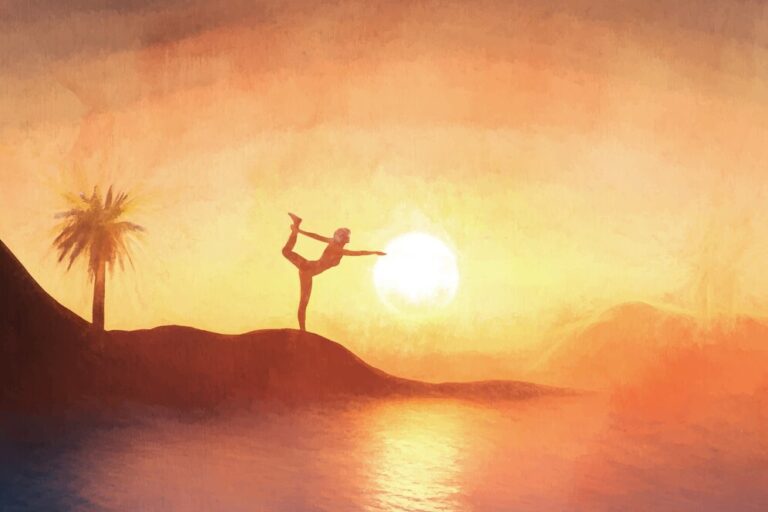![]()
Wherever you go today, you hear people talking about the multiple benefits of yoga and attesting to its indispensability in daily life. It is no surprise, considering the significance of yoga in resolving physical and mental problems worldwide. When you hear the word ‘yoga,’ you might picture people twisting into seemingly impossible poses. Perhaps you never imagined that non-acrobats could bend and twist like that!
While yoga asanas are immensely effective and helpful, yoga is more than the asanas or poses it is known for today. It is not just a passing modern fad that evolved over the last few decades. In fact, it dates back several millennia. Yes, incredible as it may sound, yoga goes way back to BC times. So, it is no wonder that so many around the world are attracted to such a time-tested practice. But let’s start at the beginning with the very meaning of yoga. What is yoga? What do we mean when we say it is more than asanas? And from when has it been practiced?
What is Yoga?
The word yoga is derived from the Sanskrit word “yuj,” which means “to join” or “to unite.” This union is not merely about your nose touching your knees as you bend to touch your toes! The union referred to is that of your mind with your body, you integrating with your surroundings and nature, and finally, your individual consciousness with the universal consciousness.
Lord Shiva is considered to be the first yogi; it is believed that He disseminated his knowledge and learning to seven learned men known as the Saptarishis. They, in turn, spread this knowledge in seven different directions covering diverse regions, conveying that humans can evolve beyond their physical limitations.
History of Yoga
I. Pre-Vedic and Vedic Period In the hierarchy of Vedic knowledge, there are four Vedas – Rigveda, Samveda, Yajurveda, and Atharvaveda. These are followed by four Upavedas or sub-Vedas – Ayurveda, Arthaveda, Dhanurveda, and Gandharvaveda. Further down the line are six upangas or components – Shiksha, Kalpa, Vyakarana, Nirukta, Chandas, and Jyotisha. These are further classified into six sub-components – Nyaya, Vaiseshika, Sankhya, Mimansa, Vedanta, and Yoga.
The earliest recorded mention of the word ‘yoga’ is in the ancient Indian text, the Rig Veda, dating back to around 1500 BC. In the Atharva Veda (1200-1000 BC), there is a mention of the importance of breath control. Although difficult to pinpoint exact dates due to the oral transmission of the Vedas initially, written records came much later. However, even before this, in the Indus-Saraswati civilization (2700 BC), several seals and fossils depict figures performing Yoga Sadhana, suggesting that yoga was known and practiced even in those early stages of civilization.
II. Pre-Classical Period The Upanishads, which explain the meanings hidden in the Vedas, elaborating on the workings of the mind and spirit through personal teachings, emerged in this era. They espouse meditation and mantra recitation towards the ultimate goal of attaining enlightenment. Out of the 108 Upanishads, 20 are dedicated to yoga, discussing different yogic techniques like pranayama (breathing exercises) and pratyahara (withdrawal of the senses).
III. Classical Period (500 BC to 800 AD) A) The teachings of Lord Mahavira and Lord Buddha formed the early basis for Yoga Sadhana. Lord Mahavira spoke of attaining salvation and freedom through meditation, while Lord Buddha spoke of specific postures and meditation to attain enlightenment.
B) The Bhagavad Gita, a dialogue between Lord Krishna (universal consciousness) and Prince Arjuna (human consciousness), emerged in this period. It explains concepts such as Dharma, Karma yoga (generous actions), Bhakti yoga (dedicated and caring actions), and Jnana yoga (knowledge).
C) Some verses of the Mahabharata (300-200 BC) also mention terms described by Sage Patanjali, such as vichara (subtle reflection) and viveka (discrimination). Goals of yoga, such as separating self from matter and uniting the individual atman with the universal Brahman, are described.
D) Maharshi Patanjali, considered the Father of Yoga, was the first to systematize the practices of yoga, believed to be in the second century BC. Through his Yoga Sutras, he disseminated the meaning of yoga and the knowledge it offers. This yoga was called Raja yoga. He formulated the Ashtanga yoga or the eight limbs of yoga: yamas, niyamas, asanas, pranayama, pratyahara, dharana, dhyan, and samadhi. Patanjali’s elements were also integrated into finger movements in nata dances and later incorporated into martial arts.
IV. Post-Classical Period In this era, sages and philosophers like Adi Shankaracharya contributed to the development and continuation of Raja Yoga and Jnana yoga, adopting and building upon previous teachings. His teachings and yogic rituals, such as Jnana Yoga, were aimed at achieving Nirvana or liberation. Meditation was also considered vital to clear the mind. Tulsidasa and Purandaradasa further contributed to the science of yoga, and Hatha yoga became popularized during this period. Most asanas practiced today are part of Hatha yoga.
V. Modern Period (1700 AD to 1900 AD) Swami Vivekananda played a significant role in spreading yoga to western societies. During this period, there was a greater focus on physical well-being. Raja yoga was further developed by figures like Ramana Maharshi, Ramakrishna Paramahansa, BKS Iyengar, K Pattabhi Jois, Paramhansa Yogananda, and Vivekananda. Yoga spread to the West in the mid-nineteenth century, with Vedanta, Bhakti, and Hatha yoga flourishing at this time.
Such has been the long and illustrious journey of yoga to reach the 21st century, with various contributors and changes along the way. Despite this, the essence of yoga remains in becoming one with yourself, your spirit, and the world around you.
Ancient vs Modern Perspective
In ancient times, people lived in harmony with nature and evolved in that state. They understood the symbiotic relationship between the body and the mind, recognizing that both must be in communion for bends and twists to be possible. Control of breath and self-realization were essential. Using yoga to treat diseases, achieve physical fitness, and attain freedom from stress is a modern, more superficial perspective. Ancient yoga was not just about removing diseases but encompassed all-round wellness, including purity of mind and thought processes.
Yoga helps you realize that you are one with the universe around you, i.e., your existence is not separate from the world around you. Once you attain this state of awareness, you will be liberated from the sufferings of the world and achieve control over your body, mind, spirit, and even your destiny. This path to self-realization and actualization is the true aim of yoga.
This profound spiritual meaning of yoga is now being recognized globally, with the United Nations designating June 21st as International Yoga Day. This day assigns yoga its rightful place as a way of life that engenders peace, harmony, and universal integration.
Reference:







